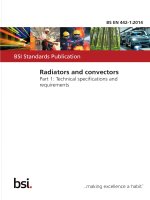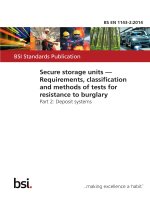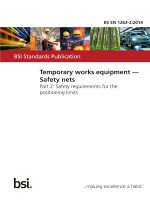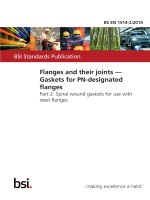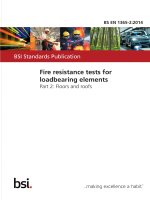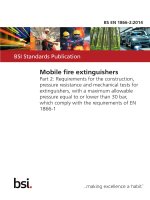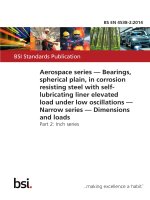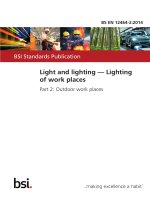Bsi bs en 00442 2 2014
Bạn đang xem bản rút gọn của tài liệu. Xem và tải ngay bản đầy đủ của tài liệu tại đây (6.37 MB, 82 trang )
BS EN 442-2:2014
BSI Standards Publication
Radiators and convectors
Part 2: Test methods and rating
BS EN 442-2:2014
BRITISH STANDARD
National foreword
This British Standard is the UK implementation of EN 442-2:2014. It
supersedes BS EN 442-2:1997 which is withdrawn.
The UK participation in its preparation was entrusted to Technical
Committee RHE/6, Air or space heaters or coolers without
combustion.
A list of organizations represented on this committee can be
obtained on request to its secretary.
This publication does not purport to include all the necessary
provisions of a contract. Users are responsible for its correct
application.
© The British Standards Institution 2014. Published by BSI Standards
Limited 2014
ISBN 978 0 580 82034 2
ICS 91.140.10
Compliance with a British Standard cannot confer immunity from
legal obligations.
This British Standard was published under the authority of the
Standards Policy and Strategy Committee on 31 December 2014.
Amendments issued since publication
Date
Text affected
BS EN 442-2:2014
EN 442-2
EUROPEAN STANDARD
NORME EUROPÉENNE
EUROPÄISCHE NORM
December 2014
ICS 91.140.10
Supersedes EN 442-2:1996
English Version
Radiators and convectors - Part 2: Test methods and rating
Radiateurs et convecteurs - Partie 2 : Méthodes d'essai et
d'évaluation
Radiatoren und Konvektoren - Teil 2: Prüfverfahren und
Leistungsangabe
This European Standard was approved by CEN on 11 October 2014.
CEN members are bound to comply with the CEN/CENELEC Internal Regulations which stipulate the conditions for giving this European
Standard the status of a national standard without any alteration. Up-to-date lists and bibliographical references concerning such national
standards may be obtained on application to the CEN-CENELEC Management Centre or to any CEN member.
This European Standard exists in three official versions (English, French, German). A version in any other language made by translation
under the responsibility of a CEN member into its own language and notified to the CEN-CENELEC Management Centre has the same
status as the official versions.
CEN members are the national standards bodies of Austria, Belgium, Bulgaria, Croatia, Cyprus, Czech Republic, Denmark, Estonia,
Finland, Former Yugoslav Republic of Macedonia, France, Germany, Greece, Hungary, Iceland, Ireland, Italy, Latvia, Lithuania,
Luxembourg, Malta, Netherlands, Norway, Poland, Portugal, Romania, Slovakia, Slovenia, Spain, Sweden, Switzerland, Turkey and United
Kingdom.
EUROPEAN COMMITTEE FOR STANDARDIZATION
COMITÉ EUROPÉEN DE NORMALISATION
EUROPÄISCHES KOMITEE FÜR NORMUNG
CEN-CENELEC Management Centre: Avenue Marnix 17, B-1000 Brussels
© 2014 CEN
All rights of exploitation in any form and by any means reserved
worldwide for CEN national Members.
Ref. No. EN 442-2:2014 E
BS EN 442-2:2014
EN 442-2:2014 (E)
Contents
Page
Foreword ..............................................................................................................................................................4
Introduction .........................................................................................................................................................5
1
Scope ......................................................................................................................................................6
2
Normative references ............................................................................................................................6
3
3.1
3.2
Terms, definitions, symbols and units ................................................................................................6
Terms and definitions ...........................................................................................................................6
Symbols and units of measurement ................................................................................................. 11
4
4.1
4.2
4.2.1
4.3
4.4
Selection of heating appliances to be tested ................................................................................... 12
Classification....................................................................................................................................... 12
Selection of models to be tested for determining the thermal outputs of a type ........................ 12
Selection of models to be tested when the variable characteristic dimension is the overall
height and the cross-section of the variable part is constant ....................................................... 12
Selection of models to be tested when the variable characteristic dimension for the type
is other than the overall height ......................................................................................................... 13
Testing samples submission and identification .............................................................................. 14
Supplementary test............................................................................................................................. 17
5
5.1
5.2
5.2.1
5.2.2
5.2.3
5.2.4
5.2.5
5.2.6
5.3
5.4
5.4.1
5.4.2
5.4.3
5.4.4
5.4.5
5.5
5.5.1
5.5.2
Equipment of laboratory and test methods ..................................................................................... 17
Principle ............................................................................................................................................... 17
Apparatus ............................................................................................................................................ 17
Test system ......................................................................................................................................... 17
Reference test installation ................................................................................................................. 17
Master radiators .................................................................................................................................. 20
Verification of test installation repeatability and reproducibility .................................................. 24
Accuracy of measuring instruments and devices ........................................................................... 29
Calibration of measuring instruments .............................................................................................. 30
Preparation for thermal output test .................................................................................................. 30
Test methods....................................................................................................................................... 30
General ................................................................................................................................................. 30
Weighing method ................................................................................................................................ 31
Electric method ................................................................................................................................... 31
Measurements and calculations ....................................................................................................... 31
Determination of the characteristic equation .................................................................................. 34
Presentation of results ....................................................................................................................... 35
Standard thermal output of a model ................................................................................................. 35
Determination of the catalogue outputs of a type made at variable water flow rate ................... 36
6
Test report ........................................................................................................................................... 36
4.2.2
Annex A (normative) Master radiators dimensional verification ................................................................ 39
Annex B (informative) Determination of pressure drop ............................................................................... 46
B.1
Introduction ......................................................................................................................................... 46
B.2
Pressure drop equation of a type...................................................................................................... 47
B.2.1 General ................................................................................................................................................. 47
B.2.2 Pressure drop characteristic equation of a model .......................................................................... 47
B.3
Test method......................................................................................................................................... 47
B.3.1 Test circuit ........................................................................................................................................... 47
B.3.2 Pressure tappings............................................................................................................................... 47
B.4
Test procedure — Setting up ............................................................................................................. 48
B.5
Measurements of differential pressures using an inverted U tube manometer ........................... 48
B.5.1 Techniques of measurement ............................................................................................................. 48
2
BS EN 442-2:2014
EN 442-2:2014 (E)
B.5.2
B.5.3
B.5.4
B.5.5
B.5.6
B.5.7
Surface tension effect ......................................................................................................................... 48
Leakage ................................................................................................................................................ 48
Air pockets in connecting piping ....................................................................................................... 48
Blocked pressure holes ...................................................................................................................... 48
Level of inlet and outlet connections ................................................................................................ 49
Damping (throttling) of excessive movement (oscillation) of inverted U tube manometer
liquid ..................................................................................................................................................... 49
Annex C (normative) Least squares regression for a model ....................................................................... 53
Annex D (normative) Analysis of test results by the method of least squares multiple regression ....... 54
Annex E (normative) Specimen of the test report ......................................................................................... 56
Annex F (informative) Apparatus and method for checking the bulk temperature measuring
devices ................................................................................................................................................. 60
Annex G (informative) Examples of typical appliances according to Table 4 ............................................ 62
Annex H (normative) Determination of the ΦM values of the master radiators primary set ...................... 71
Annex I (normative) Traceability of the thermal output measurement of radiators and convectors ....... 72
I.1
General ................................................................................................................................................. 72
I.2
Thermal output traceability ................................................................................................................ 72
I.2.1
Reference test installations ................................................................................................................ 72
I.2.2
Approved test installations ................................................................................................................ 73
I.3
Handling of the Master radiator sets ................................................................................................. 73
Annex J (normative) Calibration Procedure................................................................................................... 74
J.1
General ................................................................................................................................................. 74
J.2
RRT Organizational course ................................................................................................................ 74
J.3
Test procedure and submission of results ....................................................................................... 75
J.4
Test analysis and assessment ........................................................................................................... 75
Annex K (normative) Pretreatment and paint testing method ..................................................................... 77
Bibliography ...................................................................................................................................................... 78
3
BS EN 442-2:2014
EN 442-2:2014 (E)
Foreword
This document (EN 442-2:2014) has been prepared by Technical Committee CEN/TC 130 “Space heating
appliances without integral heat sources”, the secretariat of which is held by UNI.
This European Standard shall be given the status of a national standard, either by publication of an identical
text or by endorsement, at the latest by June 2015, and conflicting national standards shall be withdrawn at
the latest by June 2015.
Attention is drawn to the possibility that some of the elements of this document may be the subject of patent
rights. CEN [and/or CENELEC] shall not be held responsible for identifying any or all such patent rights.
This document supersedes EN 442-2:1996.
This document has been prepared under a mandate given to CEN by the European Commission and the
European Free Trade Association.
The most significant changes that have been made in this new edition of EN 442-2 are the following ones:
—
some new definitions have been added;
—
the straight or curved towel or bathroom radiator have been included;
—
different surface treatments have been included;
—
a new normative Annex J "Calibration Procedure" has been added;
—
a new normative Annex K "Pretreatment and paint testing method" has been added.
This European Standard comes from an output of the project SMT4 - CT97 - 2127 funded by the European
Commission DGXII-RDT.
This European Standard, Radiators and convectors, consists of the following parts:
—
Part 1: Technical specifications and requirements;
—
Part 2: Test methods and rating [the present document].
According to the CEN-CENELEC Internal Regulations, the national standards organizations of the following
countries are bound to implement this European Standard: Austria, Belgium, Bulgaria, Croatia, Cyprus, Czech
Republic, Denmark, Estonia, Finland, Former Yugoslav Republic of Macedonia, France, Germany, Greece,
Hungary, Iceland, Ireland, Italy, Latvia, Lithuania, Luxembourg, Malta, Netherlands, Norway, Poland, Portugal,
Romania, Slovakia, Slovenia, Spain, Sweden, Switzerland, Turkey and the United Kingdom.
4
BS EN 442-2:2014
EN 442-2:2014 (E)
Introduction
This European Standard results from the recognition that the heating appliances falling into the field of
application hereinafter stated are traded on the basis of their thermal output.
To evaluate and compare different appliances it is therefore necessary to refer to a single stipulated value,
hereinafter called the standard rated thermal output.
In addition, for low temperature systems a standard low temperature thermal output is given.
The standard thermal outputs (standard rated thermal output and standard low temperature thermal output)
are defined value taken from the characteristic equation.
The pre-requisites of the standard thermal outputs, as defined by this European Standard, are the following:
—
to be representative of the actual output of the appliance in different operating conditions;
—
to be reproducible within the tolerances defined by this European Standard, taking into account the state
of measuring techniques;
—
to be representative of the thermal outputs, obtainable under the same test conditions, of any identical
sample taken out of the current production (within the tolerances defined by this European Standard
taking into account the state of measuring techniques and methods of manufacture).
5
BS EN 442-2:2014
EN 442-2:2014 (E)
1
Scope
This European Standard defines procedures for determining the standard thermal outputs and other
characteristics of radiators and convectors installed in a permanent manner in construction works, fed with
water or steam at temperatures below 120 °C, supplied by a remote energy source.
This European Standard specifies the laboratory arrangements and testing methods to be adopted, the
admissible tolerances, the criteria for selecting the samples to be tested and for verifying the conformity of the
current production with the samples tested at the initial test.
This European Standard also defines the additional common data that the manufacturer shall provide with the
product in order to ensure the correct application of the products.
This European Standard does not apply to fan assisted radiators, fan assisted convectors and trench
convectors and to independent heating appliances.
2
Normative references
The following documents, in whole or in part, are normatively referenced in this document and are
indispensable for its application. For dated references, only the edition cited applies. For undated references,
the latest edition of the referenced document (including any amendments) applies.
EN 10088-1, Stainless steels — Part 1: List of stainless steels
EN ISO/IEC 17025, General requirements for the competence of testing and calibration laboratories
(ISO/IEC 17025)
ISO 16269-7, Statistical interpretation of data — Part 7: Median — Estimation and confidence intervals
3
Terms, definitions, symbols and units
3.1 Terms and definitions
For the purposes of this document, the following terms and definitions apply.
3.1.1
heating appliance
device having the purpose of transferring heat in order to provide specific temperature conditions inside
buildings
3.1.2
independent heating appliance
self-contained heating appliance which does not need to be connected to a remote energy source (e.g. a
boiler) as it contains its own energy source (e.g. gas fired appliances, electric appliances, air to air heat pump
appliances)
3.1.3
radiator
heating appliance produced with different materials (e.g. steel, aluminium, cast-iron) and with different designs
(e.g. plate type, column type, tube type, finned tube type), which emits heat by free convection and radiation
3.1.4
sectional heating appliances (mainly applied to radiators)
heating appliance manufactured in sections of identical design and traded in this form which can be joined
together into modular assemblies so that the desired output can be obtained
6
BS EN 442-2:2014
EN 442-2:2014 (E)
3.1.5
free convection heating appliance
heating appliance which does not contain a fan or similar device to activate the air flow over heat emitter
3.1.6
convector
heating appliance which emits heat almost entirely by free convection
Note 1 to entry:
A convector comprising at least a heat emitter and a casing which provides an unheated convective
chimney of defined height.
3.1.7
skirting convector
convector of limited height running along the base of an interior wall
3.1.8
height of the unheated convective chimney
vertical distance between the lowest edge of the convector and the bottom of the air outlet section
Note 1 to entry:
It applies to convectors only, being a main factor influencing their thermal output.
3.1.9
wet heating surface; primary heating surface
portion of the heat emitting surface which is always in contact with the primary fluid (water or steam)
3.1.10
dry heating surface; secondary heating surface
portion of the heat emitting surface which is in contact with air only (e.g. fins projecting from the wet surface)
3.1.11
family of heating appliances
group of heating appliances of similar design and construction and of identical material, positions of primary
fluid connections and other related variables that particularly affect the conditions of flow of the primary fluid
within the heating appliance
3.1.12
type of radiators/convectors
group of heating appliances of similar design whose cross-section remains unchanged while the height or
length varies or which have a systematic variation of only one characteristic dimension of the dry heating
surfaces providing that this does not affect the water side (e.g. the height of convector fins on panel radiator)
Note 1 to entry:
For the calculation in conformity to Annex D, at least three models are required.
3.1.13
model
heating appliance of defined height, length and depth within a type
3.1.14
range of heights
difference between the maximum and minimum height of the models in a type
3.1.15
module of heating appliances
reference length of the useful portion of a heating appliance
Note 1 to entry:
The module coincides with:
—
the section, in the case of sectional heating appliances;
—
a length of 1 m, in the case of non-sectional heating appliances;
7
BS EN 442-2:2014
EN 442-2:2014 (E)
—
a finned length of 1 m, in the case of finned tube convectors.
3.1.16
sample
representative heating appliance used for the determination of one or more of the performance characteristics
3.1.17
inlet water temperature
bulk temperature of the water entering the heating appliance
3.1.18
outlet water temperature
bulk temperature of the water leaving the heating appliance
3.1.19
temperature drop
difference between inlet and outlet water temperature
3.1.20
mean water temperature
arithmetical mean of inlet and outlet water temperature
3.1.21
reference air temperature
air temperature measured on the vertical line at the centre of the test booth, 0,75 m above the floor level
3.1.22
excess temperature
difference between mean water temperature and reference air temperature
3.1.23
standard excess temperature
excess temperature of 50 K as determined in the standard conditions
Note 1 to entry:
20 °C.
Inlet water temperature of 75 °C, outlet water temperature of 65 °C and reference air temperature of
3.1.24
standard excess low temperature
excess temperature of 30 K at standard flow rate
3.1.25
air pressure
air pressure measured at the test place
3.1.26
standard air pressure
101,325 kPa (1,013 25 bar)
3.1.27
water flow rate
amount of water flowing through the heating appliance per unit of time
3.1.28
standard water flow rate
water flow rate relating to standard test conditions
8
BS EN 442-2:2014
EN 442-2:2014 (E)
3.1.29
standard rated thermal output
thermal output of a heating appliance defined at 50 K excess temperature
3.1.30
standard low temperature thermal output
thermal output of a heating appliance defined at 30 K excess temperature
3.1.31
characteristic equation
power function with a specific characteristic exponent that gives the thermal output as a function of the excess
temperature at constant water flow rate
3.1.32
standard characteristic equation
characteristic equation which is valid for standard water flow rate and from which the standard thermal output
can be found for the standard excess temperature of 50 K
3.1.33
regression equation of a type
equation which gives the standard thermal outputs and the characteristic exponent of all the models within a
type as a function of one characteristic dimension
Note 1 to entry:
The regression equation for the determination of thermal outputs is a power function, in which the
characteristic exponent is a linear function of the characteristic dimension.
3.1.34
standard thermal output of the module
standard thermal output of a model divided either by the number of sections or by the length in metres
3.1.35
test pressure
relative pressure to which the heating appliance is submitted during the manufacturing process (i.e. factory
test pressure)
3.1.36
maximum operating pressure
MOP
maximum relative pressure of the system to which the heating appliance may be submitted as chosen by
manufacturer
Note 1 to entry:
The maximum operating pressure is expressed in [kPa].
3.1.37
maximum operating temperature
maximum inlet water temperature allowed by the manufacturer
3.1.38
test installation
combination of:
—
test booth and other related parts, and
—
measuring instruments and related equipment
3.1.39
test system
combination of:
9
BS EN 442-2:2014
EN 442-2:2014 (E)
—
test installation, and
—
master radiators
3.1.40
test systems circuit
group of test systems convened to comply with the specifications and procedures of this European Standard
and to a periodical comparison of test results
3.1.41
repeatability of a test installation
capability of one test installation to provide test results on one given set of master radiator within the tolerance
specified by this European Standard
Note 1 to entry:
See 5.2.4.
3.1.42
reproducibility of a test installation
capability of different test installations to provide test results on one given set of master radiators within the
tolerance specified by this European Standard
Note 1 to entry:
See 5.2.4.
3.1.43
pressure drop
difference of pressure between water inlet and water outlet of the heating appliance
3.1.44
standard pressure drop
drop in pressure between inlet and outlet of the appliance heat emitter on the primary fluid side, when the
appliance is fed at the standard water flow rate
3.1.45
supplementary test
test for the purpose of establishing the effect of minor technical modifications on the thermal output of
radiators that have already been tested
3.1.46
radiated heat output factor
Sk
assumed ratio between the radiation heat output and the overall heat output of the radiator, which is only valid
for air pressure correction purposes
3.1.47
exponent np
exponent for the air pressure correction of the measured heat output of the radiator
3.1.48
emissivity
ratio of energy radiated by a particular material to energy radiated by a black body at the same temperature
3.1.49
master radiator
sample used for the calibration of test installations
Note 1 to entry:
Master radiators are used to determine repeatability and reproducibility of the results of the test
installations (see 5.2.3).
10
BS EN 442-2:2014
EN 442-2:2014 (E)
3.2 Symbols and units of measurement
Table 1 — Symbols, quantity and units of measurement
Quantity
Symbol
Unit
Thermal output
Φ
W
Standard thermal output
ΦS
W
Modular thermal output
ΦL
W
Reference value of a master radiator
Φ0
W
Reference value of a primary set of master radiators for interlaboratory
comparisons
ΦM
W
Electrical method heat losses
ΦV
W
Electric power
Pel
W
Thermodynamic temperature
T
K
Temperature
t
°C
Inlet water temperature
t1
°C
Outlet water temperature
t2
°C
t1-t2
K
Mean water temperature
tm
°C
Reference room air temperature
tr
°C
Excess temperature
ΔT
K
Specific heat capacity
cp
J/kg∙K
Specific enthalpy
h
J/kg
Inlet water enthalpy
h1
J/kg
Outlet water enthalpy
h2
J/kg
Water flow rate
qm
kg/s
Standard water flow rate
qms
kg/s
p
kPa
pmax
kPa
Pressure drop
Δp
kPa
Repeatability tolerance
S0
-
Reproducibility tolerance
Sm
-
Overall height of the heating appliance
H
m
Range of heights
Hr
m
Overall length of the heating appliance
L
m
Length of a section
LS
m
Number of sections
NS
-
Thermal resistance
R
m ∙K/W
Time interval
τ
s
Radiated heat output factor
Sk
-
Emissivity
ε
-
Temperature drop
Pressure
Maximum operating pressure/resistance to pressure
2
11
BS EN 442-2:2014
EN 442-2:2014 (E)
4
Selection of heating appliances to be tested
4.1 Classification
4.1.1 Heating appliances shall be grouped into families and types according to the definition in this
European Standard. A family can include different types.
4.1.2 For the purposes of determining catalogue outputs, a family shall be divided into a number of
separate types (in a family of radiators there may, for example, be single or double panels, with or without
convector surfaces, using the same basic components).
4.1.3 The output of each model shall not be greater than 3 500 W and the minimum thermal output of the
selected model shall be not less than 200 W at standard excess temperature.
On request of the manufacturer lower thermal output could be tested and the deviation from the previous
requirements shall be registered in the test report.
4.2 Selection of models to be tested for determining the thermal outputs of a type
4.2.1 Selection of models to be tested when the variable characteristic dimension is the overall
height and the cross-section of the variable part is constant
4.2.1.1
When a type includes only models of height 300 mm and greater, the models to be tested within
that type shall be selected in accordance with 4.2.1.2, 4.2.1.3, 4.2.1.4 and 4.2.1.5.
If the type also includes heights below 300 mm the minimum height below 300 mm shall be tested in addition
to the above models.
For a type in which all heights are below 300 mm, only the minimum and the maximum height shall be tested.
4.2.1.2
The minimum number of models to be tested within a type is determined by the range of heights
as shown in Table 2.
Table 2 — Minimum number of models to be tested
Range of heights (m)
Hr = Hmax - Hmin
Number of models
to be tested
≤1m
3
>1m
4
4.2.1.3
The minimum length of finned coil of the models to be tested shall be 1 m or the closest to 1 m.
For skirting convectors only the finned coil length shall be the closest to 3 m. In the case of sectional radiators,
having height H ≤ 1 m, the minimum number of sections shall be 10 or the minimum length 0,8 m. For
sectional radiator having height greater than 1 m the minimum length shall be 0,45 m.
For towel radiators see 4.2.2.
4.2.1.4
In the case of Hr ≤ 1 m, the models to be tested shall be three; the minimum and maximum height
of the range and an intermediate height so that Hint is equal, to or the closest value greater than:
H int = H max -
1
2
× Hr
where
Hmax
12
is the maximum height of the type.
BS EN 442-2:2014
EN 442-2:2014 (E)
4.2.1.5
In the case of 1 m < Hr ≤ 2,5 m, the models to be tested shall be four; the minimum and maximum
height of the range and two intermediate heights so that Hint1 and Hint2 are the closest values respectively to:
H inr1 = H max - 13 × H r
and
H inr 2 = H max - 2 3 × H r
4.2.2 Selection of models to be tested when the variable characteristic dimension for the type is
other than the overall height
4.2.2.1
General principle
The minimum number of models to be tested is three, having the same overall height and respectively, the
minimum, intermediate and maximum value of the relevant characteristic dimension (see 4.2.1.4).
The measured values shall be used to determine the characteristic equation of the type.
For the equation to be valid, all the measured thermal outputs shall fall within ± 2 % of the prediction of the
equation.
If any value falls outside this range, the type shall be divided and new equations derived for each subset of the
results.
4.2.2.2
Selection of models to be tested when a type includes horizontal parallel flow models
This procedure applies to tubular radiator classified as “towel or bathroom radiators”, according to Figure G.3.
If a type includes horizontal parallel flow models, with different heights and lengths, the thermal outputs of
models having Lmin and Lmax respectively shall be tested. If there are more than 3 heights, the thermal output
for all heating appliances having Lmin and Lmax respectively shall be established using the respective
characteristic equation. For each height, the thermal output for models having length included between Lmin
and Lmax shall be linearly interpolated. The adopted procedure shall be noted in the test report.
4.2.2.3
Straight or curved towel or bathroom radiator
For “towels and bathroom radiators” having similar external size (height, length, external diameter of the
tubes) and different shape of horizontal tube (straight or curved):
If it is proved by at least 2 tests that the difference between the thermal outputs of the model having straight
tubes and the model having curved tubes, is within ± 4,0 %, then the catalogue data of the models having
curved tubes can be assumed equal to the equivalent models having straight tubes.
If the difference exceeds ± 4,0 % the models are classified as different type and so tested for any specific
geometry.
4.2.2.4
Towel and bathroom radiator water circulation
For “towel and bathroom radiator” having the same external size (height, length, depth and external diameter
of the tube) but different internal circulation of the hot water, if it is proved by at least 2 tests that the difference
between the thermal outputs of the models having different internal circulation is within ± 4,0 %, then the
catalogue data of all the models can be assumed to be equal. If the difference exceeds ± 4,0 % the models
are classified as different type and so tested for any specific internal water circulation.
13
BS EN 442-2:2014
EN 442-2:2014 (E)
4.2.2.5
Different surface treatments (chromed, polished, etc.)
Models having same external size (height, length, depth and external diameter of the tube) but different
surface treatment (i.e. painted, chromed or mechanically polished), shall be tested as follows:
a)
Models painted and chromed shall be tested according to 4.2;
b)
For models having other surface treatments (e.g. satinated or polished) the minimum number of samples
to be tested shall be defined as follow:
1)
for each other type, two models, having the minimum and the maximum heat output as measured on
painted model, shall be tested only to determine the less favourable reduction coefficient;
2)
the thermal output of all the models, shall be calculated using the reduction coefficient determined
according to Point 1).
4.2.2.6
Influence of water flow rate on thermal output
On request of manufacturers the influence of water flow rate on thermal output shall be verified.
In this case additional characteristics shall be tested, setting half and double standard mass flow.
4.3 Testing samples submission and identification
4.3.1 On initial application for the testing of a family of heating appliances, or of a type within a family,
heating appliance samples and product drawings shall be submitted to the testing laboratory.
Product drawings shall be submitted by the manufacturer.
4.3.2
The product drawings shall:
—
show all dimensions and features having an influence on the heat emission, including the detail of welds
or other assembly methods used;
—
state the type of material and the nominal material thicknesses of wet or dry surfaces, with the thickness
tolerances, and type of paint;
—
shall be identified by the drawing number and the date of revision.
4.3.3 Before proceeding with the thermal output testing, the laboratory shall identify the appliance against
the drawing and shall note conformity of the sample with the drawing in respect of:
—
dimensional tolerances given in Table 3;
—
material thickness tolerances of convective surfaces, shown on the product drawings.
The laboratory shall also measure the mass and the water content of the sample models. The relevant values
shall be reported in the test report.
The models for test shall be selected as specified in 4.2.
4.3.4 Samples of heating appliances already in production shall be taken from the production line or
manufacturer's stock by the laboratory or its authorized representative.
Samples of prototype appliances shall be submitted by the manufacturer.
14
EN 442-2:2014 (E)
Table 3 — Dimensional tolerances
Dimensions in millimetres or %
STEEL RADIATORS
a
Overall height of
heat exchanger
Panel Radiators
Tubular
Sectional
Lamellar
H ≤ 250
250 < H ≤ 500
CAST
IRON
(per section)
EXTRUDED
ALUMINIUM
(per section)
CAST
ALUMINIUM
(per section)
FINNED TUBE
CONVECTORS
± 3,0
+4/-2
+4/-2
±2
+4/-2
± 3,5
500 < H < 600
± 2,5
600 < H ≤ 900
+5/-2
+5/-2
±2
+5/-2
900 < H
+6/-2
+6/-2
±2
+6/-2
+4 /-3
± 1,5
±2
± 2,5
Height of
Casing
(HC)
± 4,0
+4/−2
+5/−2
+6/−2
Overall depth
of heat
exchanger
All measures
±2
D ≤ 100
±2
100 < D
±3
Curved
models
±5
± 0,65
+0/-1
Depth of Casing
(DC)
+ 4 / −3
±5
15
EN 442-2:2014 (E)
STEEL RADIATORS
Overall Length
of heat
exchanger
Panel Radiators
All measures
L ≤ 1 000
±5
1 000 < L
± 0,5 %
Height
convector
surfaces
of
Depth
convector
surfaces
of
Tubular
Sectional
Lamellar
± 1,5 %
± 1,5 %
± 1,5 %
a
16
of
EXTRUDED
ALUMINIUM
(per section)
CAST
ALUMINIUM
(per section)
± 1,5 %
± 0,65
± 0,2
FINNED TUBE
CONVECTORS
Length of
Casing
(LC)
±5
± 0,5 %
+ 3 / - 1,5
+ 3 / - 1,5
+ 3 / - 1,5
+ 0,2 / - 0
+ 0,2 / - 0,8
Height of fins
(HF)
±1
± 1,5
±2
± 1,5
+ 0,2 / - 0
+ 0,2 / - 0,8
Depth of fins
(DF)
±1,5
± 0,5
± 0,5
+ 0 / - 1,2
+ 0,8 / - 1,2
Distance between
connection centre
Material
thickness
convectors
CAST
IRON
(per section)
± 0,06
±0,06
For tubular radiators, height refers to the dimension across header sections regardless of orientation of wall mountings.
±2
Material
thickness of fins
(TF)
± 0,05
Number of fins
(NF)
±5%
Finned length
±5%
Distance casing
to fins (TA)
±5
Distance casing
to fins (BA)
±5
BS EN 442-2:2014
EN 442-2:2014 (E)
4.4 Supplementary test
Upon manufacturer's request minor technical modifications may be investigated.
The testing laboratory investigates the effect of the change on heat output.
If the supplementary test reveals a deviation within ± 4,0 % of the measured standard rated thermal output,
the manufacturer may declare the old value of the standard thermal output.
If the difference exceeds ± 4,0 % the models are classified as a different type in accordance with 4.2.
The findings of the supplementary test shall be demonstrated as follows:
—
in the case of an assessment based on a visual check: by a written confirmation with the reference to the
new drawing submitted by the manufacturer;
—
in the case of measurements: by a complete test report.
5
Equipment of laboratory and test methods
5.1 Principle
The aim of the test is to determine the standard thermal outputs of the heating appliance using its standard
characteristic equation, which is to be obtained according to 5.4.5.
5.2 Apparatus
5.2.1
Test system
For the purposes of this European Standard, a test system shall consist of:
a)
a test installation;
b)
a set of three master radiators built according to 5.2.3.
For the purposes of this European Standard, test installations are classified as reference and approved.
5.2.2
5.2.2.1
Reference test installation
General
The reference test installation shall contain the following equipment:
a)
a closed unventilated booth comprising the test space within which the heating appliance under test is to
be installed, equipped with water cooled surfaces to maintain specific thermal conditions independent of
the external ambient, built according to 5.2.2.2;
b)
apparatus for cooling the water circulating in the walls of the closed booth;
c)
a primary heating circuit feeding the appliance under test, built in accordance with 5.4;
d)
measuring and checking instruments complying with the requirements of 5.2.5 and 5.2.6.
17
BS EN 442-2:2014
EN 442-2:2014 (E)
5.2.2.2
5.2.2.2.1
Reference test booth
Test booth dimensions
The test booth shall have the following internal dimensions:
—
length: (4 ± 0,02) m;
—
width: (4 ± 0,02) m;
—
height: (3 ± 0,02) m.
5.2.2.2.2
Test booth construction
The test booth shall be constructed with sandwich panels cooled by water (see Figure 1). The internal surface
of the booth shall be smooth and made from flat sheets of steel. The sandwich panels (see Figure 1 and
Figure 2) are made up of:
—
a steel panel, water cooled;
—
insulating foam injected between the steel panel and an external steel sheet, to form a single selfsupporting body;
—
an external steel sheet, 0,6 mm nominal thickness.
The steel water cooled panels (see Figure 3) are made up of two sheets welded together:
—
one flat having 2 mm thickness;
—
the other of 1 mm thickness having undulating shape to form waterways with a cross-section
2
approximately 150 mm .
The thickness of the insulating foam layer shall be 80 mm. The minimum overall thermal resistance of each
2
wall, floor and ceiling shall be 2,5 m K/W. The wall behind the appliance under test is made by the same
sandwich panels but it is disconnected from the cooling system (the steel panels are empty). The inside
surfaces of the test booth shall be covered with a dull paint having an emissivity of at least 0,9. The panels are
assembled so that the structure of the test booth is self-supporting, without thermal bridges (see Figure 4).
The connections of the cooling panels to the circuit are made following a three-pipe circuit scheme
(see Figure 5). The holes allowing water and electric connections with the outside of the test booth are
provided with devices for air tightness.
5.2.2.2.3
Tightness of the test booth
The test booth construction shall be sufficiently tight to prevent uncontrolled air infiltration.
5.2.2.2.4
Cooling system
The water cooling system shall be designed in such a manner that at the highest admissible output of the
testing appliance, the temperature difference occurring on the cooled internal surfaces of the test booth will
not be more than ± 0,5 K compared with the average temperature of all cooled surfaces. In order to ensure
2
this, each panel shall be supplied with a flow rate of at least 80 kg/h per m of internal surface. This condition
is a pre-requisite for operating the test booth.
During the tests the average temperature of the cooled internal surface shall be regulated so that the
reference air temperature will be (20 ± 0,5) °C and will comply with steady-state conditions.
18
BS EN 442-2:2014
EN 442-2:2014 (E)
The surface average temperature is the mean of the inlet and outlet water temperatures of the relevant
surface.
5.2.2.3
5.2.2.3.1
Measurements in the booth
Temperature measurements in the booth
Temperature measurements shall be made in the booth:
—
to determine the reference room temperature;
—
to monitor the thermal state of the test installation.
5.2.2.3.2
Air temperature measuring points
On the central vertical axis of the booth:
a)
at the reference air temperature point 0,75 m from the floor,
b)
at the following additional points:
1)
0,05 m from the floor,
2)
1,50 m from the floor,
3)
0,05 m from the ceiling.
19
BS EN 442-2:2014
EN 442-2:2014 (E)
Dimensions in millimetres
Figure 1 — Sandwich panel cooled by water
5.2.2.3.3
Temperatures of the internal surfaces
On the back beside wall apart from the central point, a point on the centre axis at 0,5 m from the floor.
The surface temperatures (excluding those of the wall behind the heating appliance) shall be maintained
within a ± 0,3 K spread.
5.2.2.3.4
Other measurements
Air pressure.
5.2.3
5.2.3.1
Master radiators
General
The purposes of the master radiators are the following:
a)
20
to verify that the reproducibility of test values among test installations is within the limits set by this
European Standard;
BS EN 442-2:2014
EN 442-2:2014 (E)
b)
to verify that reference and approved test installations give test results within the limits set by this
European Standard;
c)
to establish a common basis for all test installations in verifying that the repeatability of test values in each
laboratory is within the limits set by this European Standard.
To verify the reproducibility among test installations built to the present European Standard, a single set of
master radiators constructed and verified according to the present European Standard will be circulated
among reference test installations to determine the respective Φ0 and ΦM values (see 5.2.4.3.3).
This single set of master radiators is named “primary set”. Each laboratory shall equip itself with a set of
master radiators constructed and verified to the present European Standard. This set, named “secondary set”,
shall be used to verify the repeatability of the test installation. The secondary set of one reference test booth,
shall be used to verify the reproducibility of approved test installations.
Dimensions in millimetres
Figure 2 — Sandwich panel cooled by water with hole for external connections
21
BS EN 442-2:2014
EN 442-2:2014 (E)
Dimensions in millimetres
Figure 3 — Steel water cooled panel cross-section
Key
1
air tight opening for electric and water connections
Figure 4 — Panel assembly
22
BS EN 442-2:2014
EN 442-2:2014 (E)
a) Water piping scheme
b) Main chilled water circuit (example)
Key
1
electric re-heater
R
refrigerant circuit connection
As
air separator
Figure 5 — Cooling circuits
23

